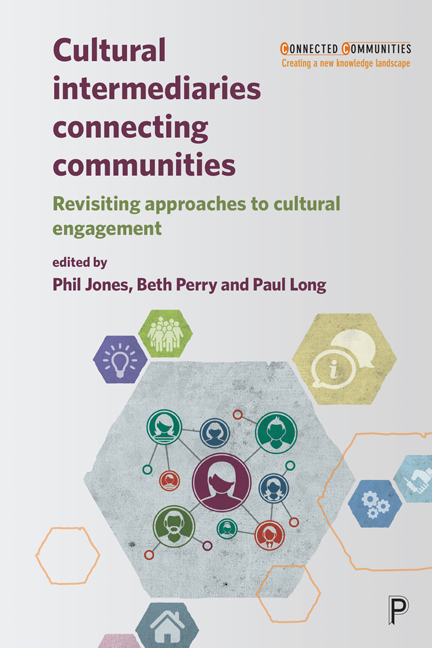Book contents
- Frontmatter
- Contents
- List of figures, tables and boxes
- Notes on contributors
- Acknowledgements
- Series editors’ foreword
- Introduction: Bringing communities and culture together
- Part One Changing contexts
- Part Two Practices of cultural intermediation
- Part Three Evaluation, impact and methodology
- Conclusion: where next for cultural intermediation?
- Index
Introduction: Bringing communities and culture together
Published online by Cambridge University Press: 30 April 2022
- Frontmatter
- Contents
- List of figures, tables and boxes
- Notes on contributors
- Acknowledgements
- Series editors’ foreword
- Introduction: Bringing communities and culture together
- Part One Changing contexts
- Part Two Practices of cultural intermediation
- Part Three Evaluation, impact and methodology
- Conclusion: where next for cultural intermediation?
- Index
Summary
Introduction
The words ‘communities’ and ‘culture’ are some of the most contested in the English language. The launch in 2010 of the Connected communities funding programme by the UK's Arts and Humanities Research Council (AHRC) provoked a great deal of debate among the academics and practitioners involved about precisely what these ambiguous concepts underpinning the programme meant in practice. This book, based on research funded by the Connected communities programme, emerges from a key theme within these initial debates, which raised questions about the ways in which ideas of culture and creativity can be positioned as mitigating social exclusion and multiple deprivation.
Underpinning this book is a need to problematise a crude assumption that people living in poverty can have their lives enriched by engaging with cultural activity of different kinds. The ambiguous meaning of culture in this context is one of the key problems with the simple formulation that ‘culture is good for you’, and the assumption that there is an absence in the lives of those in need of its benefits. A key element here is a well-established literature demonstrating that people from a range of socioeconomic backgrounds consume a wide variety of different cultural forms every day. We can say, therefore, that there is nothing particularly unusual about engaging with culture even if you are suffering from the effects of structural poverty and inequality (Miles and Sullivan, 2012). If people are already connecting with cultural forms, this raises questions about the types of culture that people are connecting with and the manner of that connection. Does watching television somehow have less of a positive impact on people's lives than visiting an art gallery? Is online video gaming more or less beneficial than going to the opera? Are communal rituals of singing, reading and recitation associated with religious observance aligned or at odds with the parameters of good culture?
Of course, choosing to engage with different cultural forms is a matter of individual taste, but that taste is mediated through socioeconomic position, cultural capital and the market mechanisms that support some manifestations of culture over others. Pierre Bourdieu (1984) talked about tastes being informed by ‘cultural intermediaries’, highlighting the role of journalists whose role was to notify communities about the kinds of (high) cultures they should consume.
- Type
- Chapter
- Information
- Cultural Intermediaries Connecting CommunitiesRevisiting Approaches to Cultural Engagement, pp. 1 - 24Publisher: Bristol University PressPrint publication year: 2019



